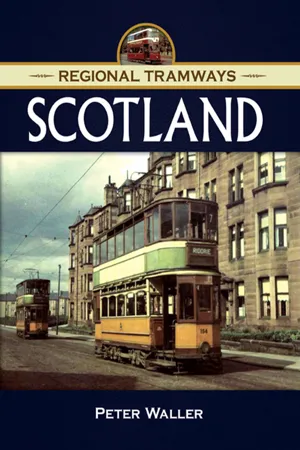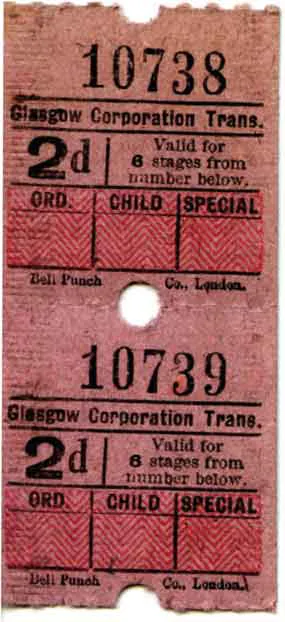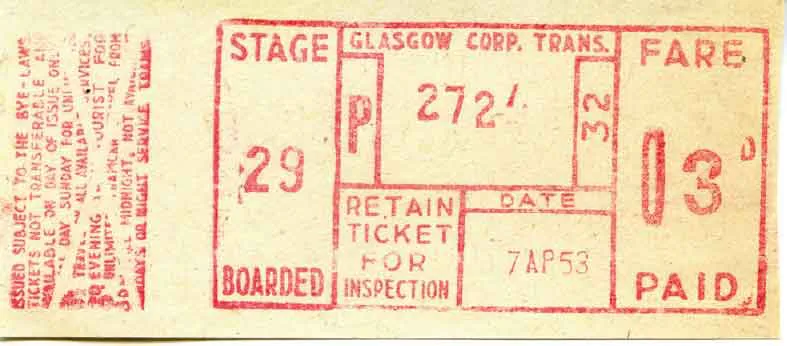![]()
GLASGOW
At the end of the Second World War, Glasgow possessed the largest tramway system in the British Isles. It possessed a fleet of some 1,200 cars, although relatively few were modern, and – courtesy of expanding over the lines of the Airdrie and Paisley companies – its operations spread well outside the city’s boundaries. With the benefit of hindsight it is possible to see the seeds of the system’s ultimate fate in those two facts – the age of the fleet and the operations beyond the boundaries – but at the time little seemed to threaten this great system. Indeed, such was the belief in the tram that in early 1945, Robert Bruce, the city engineer, produced a report on the future development of public transport in the city in which he stated that it ‘would consist mainly of railed vehicles driven by electricity’. He foresaw the use of subways with single-deck cars and envisaged that the first stage would take place in 15 to 20 years.
Map of the Glasgow network as at 1945.
Glasgow hex-dash ‘Standard’ No 128 stands at Burnside on 4 April 1948 awaiting departure with a route 18 service to Springburn. Michael H. Waller
After the cessation of hostilities, little dramatic occurred. There were some minor route alterations in the summer of 1945: route 10 was revised to reverse at Hyndland Road; route 10A (a circular route via Church Street) was withdrawn; route 5 was also revised to reverse at Hyndland Road with alternative cars running via Botanic Gardens or Highburgh Road with a new crossover just short of the Kelvinside terminus; and route 16 now diverted to run via Elmbank Street rather than North Street, with the latter track now disused, via a new curve fitted with an electric point at the junction of Bothwell Street and Elmbank Street. Also in 1945 the construction of a new single-ended car – destined to be No 1005 – had been approved, and work repairing the railway bridge at Finnieston had required trams to operate over 100 yards of single track temporarily.
The scene at the Auchenshuggle terminus of route 9 to Dalmuir West on 23 March 1949 sees round-dash ‘Standard’ No 341 awaiting departure; some 13 years later, this particular route was destined to be the last converted to bus operation. Michael H. Waller
On 23 March 1949 ‘Standard’ No 238 is pictured at Bishopbriggs with a service on route 25 to Carnwadric; the extension to Carnwadric was one of the few extensions completed in Scotland post-war. Michael H. Waller
Seen at the Renfrew Ferry terminus of route 28 to Glenfield is, appropriately, ex-Paisley car No 1053; this terminus was modified slightly in the late 1950s. Michael H. Waller
However, towards the end of the year Modern Tramway reported ‘news of a similarly disquieting nature’; the news was that the general manager, E. R. L. Fitzpayne, had proposed the experimental conversion of route 2 (between Provanmill and Aikenhead Road) to trolleybus operation. He also proposed the abandonment of the Clydebank to Duntocher route, which required the use of single-deck cars, and the section from Broomhouse to Uddingston. There was also a proposal to see night trams replaced by buses with an increase in fares from 1d to 3d (this was rejected by the Traffic Commissioners early in 1946 unless the maximum fare was 2d). Despite these proposals, Fitzpayne remained adamant that the tram remained central to Glasgow’s transport provision and this was reflected early in 1946 by the agreement to purchase 100 new trams (although the experimental use of trolleybuses also remained on the agenda). Although the cost for 100 bogie trams was greater than that for an equivalent of four-wheel cars, Fitzpayne argued the committee ‘might decide that only the best was good enough for Glasgow’. Approval was also given in early 1946 for the extension of the Knightswood route to South Drumry at a cost of £26,000. Also during 1946, a fares increase was implemented on 18 August that resulted in a 4d maximum on the trams. In addition, revised traffic control at Eglinton Toll resulted in the creation of two separate highways and the consequent diversion of routes 5, 5A, 11, 14 and 24 the same day. This diversion was not popular with regular passengers whose journeys had been adversely affected.
The following year was relatively quiet, although in the late summer a new quarter-mile branch to serve the housing estate at Carnwadric from Boydstone Road at Thornliebank was proposed and, later in the year, powers were formally granted to permit the operation of trolleybuses in the city. These plans were not considered a serious threat to the existing tram network as no trunk tram route was threatened and the new trolleybuses were also expected to serve areas beyond the tram termini. Mention has already been made of the age of the fleet and the number of routes outside the city’s boundaries; by the late 1940s another major problem also emerged – the transport department’s financial position. During the financial year ended 31 March 1946, the trams and buses lost about £130,000 each and, in mid-1948, the estimated loss to 31 March 1949 was £400,000 and that the total debt to 31 March 1948 was already £1 million. Fare increases were again implemented during the summer of 1948 but, increasingly, more radical solutions were deemed necessary. In the summer of 1948 Fitzpayne proposed that, although the core tramway network be preserved (indeed be invested in as the idea of subways remained a possibility), the more outlying sections be converted to trolleybus operation.
On 24 March 1949, ‘Coronation’ No 1238 stands at the then Spiersbridge terminus of route 14; with the withdrawal of trams on route 28 between Cross Stobs and Glenfield in early April, service No 14 was extended beyond Spiersbridge to serve Cross Stobs. Until 1923 and Glasgow’s takeover of the tram operations of Paisley District Tramways Co, there was no physical connection between the two systems at Spiersbridge. Michael H. Waller
Glasgow experimented with the Ultimate-style ticket system from 1948 and this is one of five ticket values known to have been issued in the first series produced that year. Author’s Collection
The Ultimate system gradually replaced the TIM machines in use previously and all the latter were largely superseded by the end of 1953. This TIM was issued towards the end of this period, on 7 April 1953, on route 32 (Crookston to Bishopbriggs). Author’s Collection
The scene in Newlands Depot after the disastrous fire of 1948. Michael H. Waller
The section of route 28 between Glenfield and Cross Stobs, which was largely single track with passing loops, was abandoned on 2 April 1949. On 24 March 1949, shortly before the abandonment of the route south from here, ex-Paisley No 1063 stands at Glenfield with a service to Renfrew Ferry. Michael H. Waller
The tramcar fleet reached its peak in 1948, with 1,200 in service, but these were to be reduced following the disastrous fire in Newlands Depot on 11 April 1948. This resulted in the loss of a number of ‘Standard’ and ‘Coronation’ cars, although the latter were repaired or rebuilt; the first to be repaired was No 1239. The insurance payment received allowed for the construction of eight replacement ‘Coronation’ cars – 1255/79/393-98 – during 1954 and 1955; Nos 1393-98 were constructed using EMB trucks acquired second-hand from Liverpool. More positively, the year witnessed the introduction of the first of the post-war ‘Cunarder’ cars with deliveries from the summer running at two per week from Coplawhill Works. Also positive was the opening of the branch to Carnwadric; this commenced operation as route 14B on 7 April 1948 with a 12min headway. The long-foreshadowed withdrawal of the outer section of route 29 from Broomhouse to Uddingston, however, took place on 28 August 1948. There was a slight extension on 3 October 1948 when a new siding serving route 4 to Renfrew South opened. This extended for about a quarter of a mile along Porterfield Road.
Glasgow’s plans for introducing trolleybuses were gathering pace. On 23 January 1949 buses replaced trams on the Oatlands to Townhead section of route 10 and were scheduled to replace trams temporarily on routes 2 (Provanmill to Polmadie) and 19 (Muirend to Springburn) to permit the erection of trolleybus overhead (these conversions actually took place on 20 February 1949). These changes resulted in the following route alterations, although little track was actually abandoned at this stage: route 10 and new route 36 now operated between Kelvinside and Parkhead Cross by two alter...










